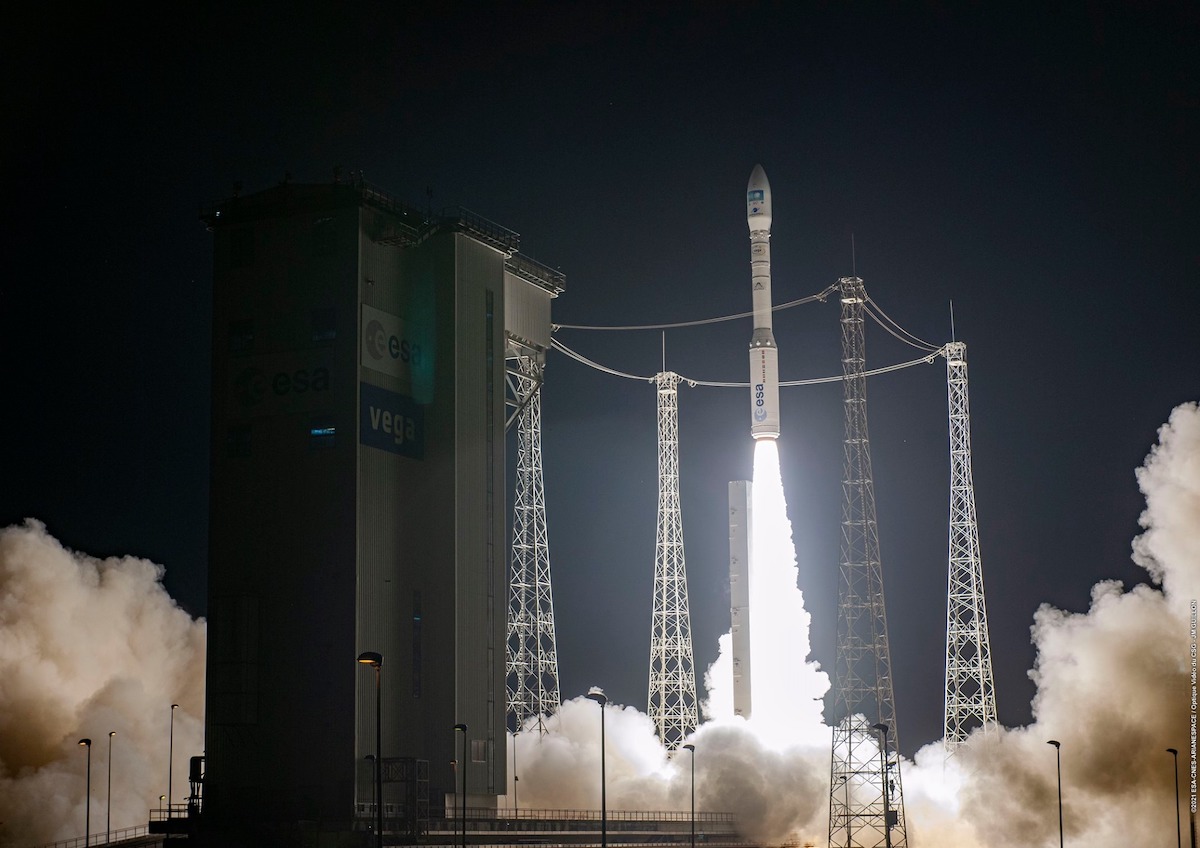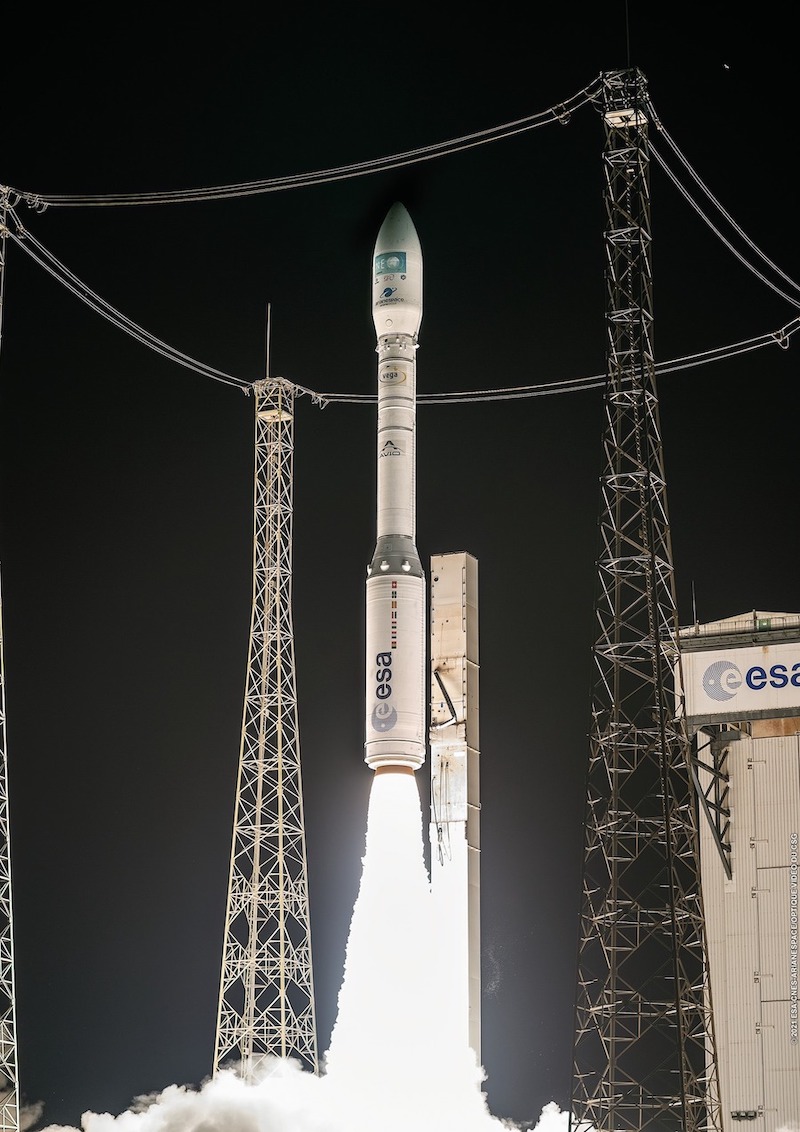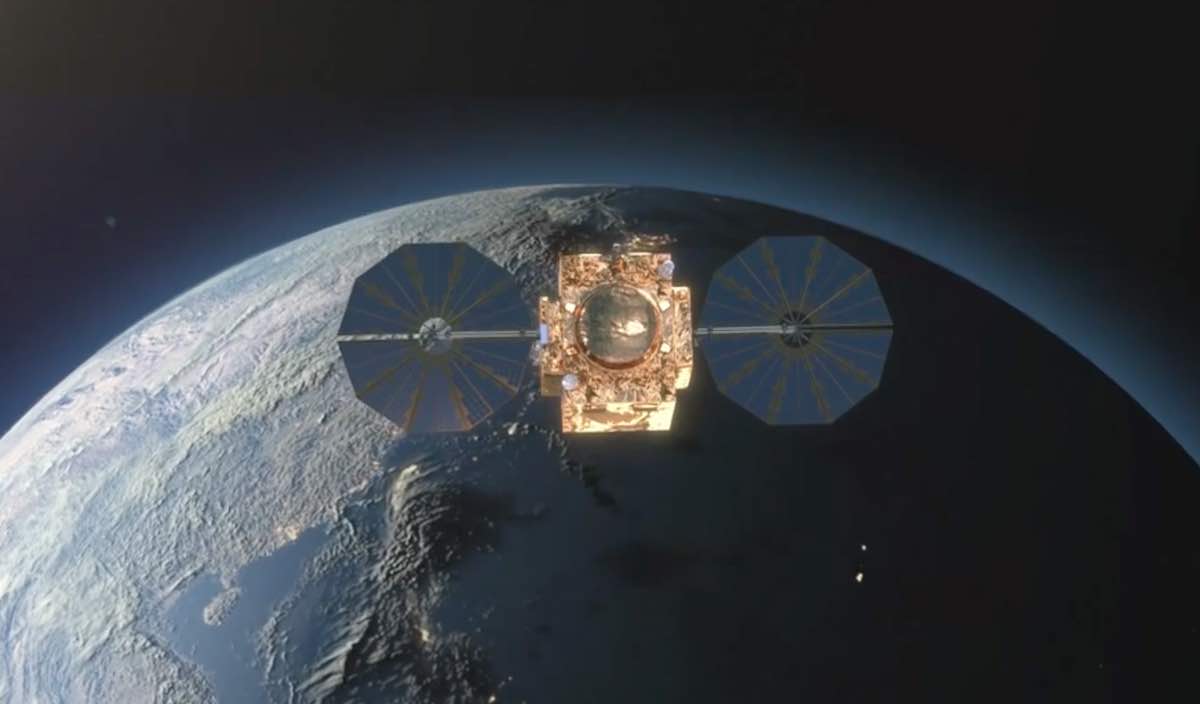
A European Vega rocket deployed six commercial satellites in orbit, including a new Airbus-built eye-in-the-sky for high-resolution Earth-imaging, on a successful launch from French Guiana on Wednesday night after two of the last three Vega missions failed.
The 98-foot-tall (30-meter) Vega rocket fired off its launch mount at the Guiana Space Center in South America at 9:50:47 p.m. EDT Wednesday (0150:47 GMT Thursday) and rapidly climbed through the atmosphere, exceeding the speed of sound in just 31 seconds.
Heading north over the Atlantic Ocean, the Vega rocket’s first stage booster consumed its pre-packed solid propellant in two minutes, then jettisoned as the second stage’s solid-fueled motor ignited to continue the ascent into space. A third stage solid motor later ignited, then a hydrazine-fed reignitable fourth stage engine fired to precisely place the mission’s six satellite payloads into two distinct orbits.
The fourth stage deployed Airbus’s Pléiades Neo 3 remote sensing satellite into a polar orbit about 54 minutes after liftoff. After separating from the rocket at an altitude of 392 miles (632 kilometers), the Pléiades Neo 3 spacecraft unfurled its two fan-shaped solar arrays and contacted ground controllers at Airbus’s operations center in Toulouse, France.
Two more brief firings of the upper stage moved the rocket to a slightly lower altitude for separation of five small secondary payloads for commercial customers in the United States, France, and Norway.
Arianespace, the French launch services company that oversees Vega flights, declared the mission a success.
“A successful mission tonight, and especially a big relief,” said Daniel Neuenschwander, director of space transportation at the European Space Agency, which participated in the recent Vega failure investigations in its role as qualification authority for the rocket program.
The launch is crucial for Arianespace, the French launch services firm that oversees Vega launches, and Italy-based Vega prime contractor Avio. Two of the last three Vega rockets have failed to place their payloads into orbit, for different reasons.

After 14 straight successful flight since its debut launch, a Vega rocket lost control about two minutes after liftoff in July 2019 with the Falcon Eye 1 military surveillance satellite for the United Arab Emirates. The launcher and payload crashed into the Atlantic Ocean.
Investigators traced the cause of the accident to a “thermo-structural failure” on the forward dome of the Vega rocket’s solid-fueled second stage, allowing hot gas to damage the motor’s casing and leading to the in-flight breakup of the launch vehicle.
Engineers beefed up thermal insulation and improved quality control checks, and the next Vega launch in September 2020 successfully placed 53 small commercial and government satellites into orbit, a record number of payloads on a single Arianespace mission.
But failure struck again on the next Vega launch Nov. 16.
Engineers determined a problem on the rocket’s liquid-fueled fourth stage caused the loss of the Spanish SEOSAT-Ingenio Earth observation satellite and the French space agency’s Taranis research satellite.
Officials concluded that cables leading to thrust vector control actuators on the Vega’s Attitude and Vernier Upper Module, or AVUM, were inverted, a mistake from the assembly of the upper stage engine. The thrust vector control system pivots the upper stage engine nozzle to direct thrust, allowing the rocket to control its orientation and steering.
Quality control checks before the launch missed the cable installation error, which caused the engine to move its nozzle in the wrong direction in response to commands from the rocket’s guidance system. That resulted in the rocket losing control and tumbling just after ignition of the upper stage engine around eight minutes after launch with the SEOSAT-Ingenio and Taranis satellites.
“We really went through highs and lows in the past years with Vega,” Neuenschwander said. “First of all, 14 successes in a row. It was great. Then a mishap with VV15, back to success with VV16, where we had a proof of concept of the Small Spacecraft Mission Service, which was really a proof of concept and which showed that we can address new markets with existing products.”
The SSMS multi-payload adapter structure flew again on Wednesday night’s mission to accommodate five rideshare payloads mounted below the Pléiades Neo 3 inside the Vega rocket’s payload fairing.
“We are definitely now on a good path, and let’s make it now a sustainable path,” Neuenschwander said.
Officials from Arianespace and the European Space Agency stressed last year that the failure on the Nov. 16 launch was attributable to human error, and not a design fault like the one that caused the July 2019 launch mishap.
Misleading instructions and inadequate preflight checks caused teams to overlook wrongly-installed cables on the launcher’s upper stage steering system, officials said.
Managers ordered additional inspections of already-built rocket components to ensure they are free of the problem that caused the failure in November, clearing the way for a resumption of Vega missions.
Giulio Ranzo, CEO of Italy-based Avio, said he felt “a lot of relief” after Wednesday’s launch success.
“We have gone through a very intense effort over the last five months, checking, re-checking, and re-re-checking everything on the launcher to get ready for flight,” Ranzo said. “Of course, it has been quite emotional to come back to flight and to perform well.”
The Vega rocket debuted a new telemetry transmitter to beam flight data to ground teams via NASA’s Tracking and Data Relay Satellite System. The capability is common to U.S. launch vehicles but new to European rockets, eliminating long stretches of communications outages as the launcher flies between ground stations.
Arianespace has found success in selling Vega launches to ESA and the European Commission, which owns Europe’s fleet of Copernicus environmental satellites. National space agencies across Europe and in other parts of the world have also purchased rides on Vega rocket for their small satellites.
Startups and other commercial satellite operators have also secured slots on Vega rideshare missions, including the launch set to blast off Wednesday night.
The Vega rocket can deliver about 3,300 pounds (1.5 metric tons) of payload to a 435-mile-high (700-kilometer) sun-synchronous orbit.
An upgraded version called the Vega C will feature larger first and second stage motors, plus a widened payload berth, increasing the rocket’s payload carrying capacity to about 4,850 pounds (2.2 metric tons) to the same orbit. The first Vega C launch is now scheduled for early 2022.
The Pléiades Neo 3 spacecraft launched Wednesday night will improve on Airbus’s first-generation Pléiades Earth observation satellites launched in 2011 and 2012.
The next Vega launch — expected in July — will carry the identical Pléiades Neo 4 satellite into orbit, and a Vega C launch in 2022 will loft the final two Pléiades Neo payloads on a single mission, taking advantage of the new rocket’s increased carrying capacity.

Airbus says it entirely funded the development of the Pléiades Neo satellites, with intentions to sell the imagery commercially to private companies and government users. The company assembled the spacecraft at its facility in Toulouse, France.
“The launch of this first Pléiades Neo satellite will pave the way to new services and great opportunities for our customers, thanks to its high accuracy and increased reactivity. The Pléiades Neo constellation will definitively boost the 30cm (11.8-inch) imagery market, bringing a lot of innovation and coverage capacity to the commercial and governmental end-users,“ said François Lombard, head of intelligence at Airbus Defence and Space.
The imaging resolution of Airbus’s four Pléiades Neo satellites is comparable to the resolution provided by Maxar’s six-satellite WorldView Legion surveillance satellites due to begin launching later this year. The companies are competitors, providing the highest-resolution Earth observation imagery on the global commercial market.
With the help of laser inter-satellite communications links, the Pléiades Neo satellites will be able to respond rapidly to tasking requests within 30 to 40 minutes, according to Airbus.
The five rideshare payloads on Wednesday night’s mission included Norsat 3, a 35-pound (16-kilogram) Norwegian Space Agency satellite that fuses an experimental on-board radar detector with a Automatic Identification System receiver to track maritime ship traffic.
There was also a briefcase-sized satellite built by NanoAvionics integrated with a radio frequency characterization payload from Denver-based startup Aurora Insight. The new Bravo satellite joins the identical Charlie smallsat that flew into orbit on a SpaceX rideshare mission in January.
Two commercial CubeSats — also about the size of a briefcase — were deployed from the Vega launcher to join Spire’s ship tracking and commercial weather data collection fleet.
There was also a small pathfinder satellite on the Vega rocket for Eutelsat’s planned constellation of narrowband data relay satellites. The ELO Alpha spacecraft, built by California-based Tyvak Nano-Satellite Systems, will allow Eutelsat to gauge how low Earth orbit satellites might augment services provided by the company’s large geostationary communications satellites.
Email the author.
Follow Stephen Clark on Twitter: @StephenClark1.